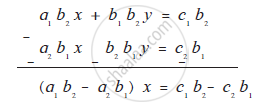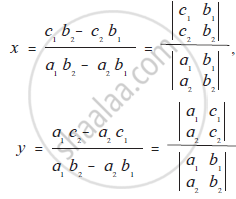Topics
Linear equations in two variables
- Introduction to linear equations in two variables
- Methods of solving linear equations in two variables
- Simultaneous method
- Simultaneous method
- Substitution Method
- Cross - Multiplication Method
- Graphical Method
- Determinant method
- Determinant of Order Two
- Equations Reducible to a Pair of Linear Equations in Two Variables
- Simple Situational Problems
- Pair of Linear Equations in Two Variables
- Application of simultaneous equations
- Simultaneous method
Quadratic Equations
- Quadratic Equations
- Roots of a Quadratic Equation
- Solutions of Quadratic Equations by Factorization
- Solutions of Quadratic Equations by Completing the Square
- Formula for Solving a Quadratic Equation
- Nature of Roots of a Quadratic Equation
- The Relation Between Roots of the Quadratic Equation and Coefficients
- To Obtain a Quadratic Equation Having Given Roots
- Application of Quadratic Equation
Arithmetic Progression
- Introduction to Sequence
- Terms in a sequence
- Arithmetic Progression
- General Term of an Arithmetic Progression
- Sum of First ‘n’ Terms of an Arithmetic Progressions
- Arithmetic Progressions Examples and Solutions
- Geometric Progression
- General Term of an Geomatric Progression
- Sum of the First 'N' Terms of an Geometric Progression
- Geometric Mean
- Arithmetic Mean - Raw Data
- Concept of Ratio
Financial Planning
Probability
- Probability - A Theoretical Approach
- Basic Ideas of Probability
- Random Experiments
- Outcome
- Equally Likely Outcomes
- Sample Space
- Event and Its Types
- Probability of an Event
- Type of Event - Elementry
- Type of Event - Complementry
- Type of Event - Exclusive
- Type of Event - Exhaustive
- Concept Or Properties of Probability
- Addition Theorem
Statistics
- Tabulation of Data
- Inclusive and Exclusive Type of Tables
- Ogives (Cumulative Frequency Graphs)
- Applications of Ogives in Determination of Median
- Relation Between Measures of Central Tendency
- Introduction to Normal Distribution
- Properties of Normal Distribution
- Concepts of Statistics
- Mean of Grouped Data
- Method of Finding Mean for Grouped Data: Direct Method
- Method of Finding Mean for Grouped Data: Deviation Or Assumed Mean Method
- Method of Finding Mean for Grouped Data: the Step Deviation Method
- Median of Grouped Data
- Mode of Grouped Data
- Concept of Pictograph
- Presentation of Data
- Graphical Representation of Data as Histograms
- Frequency Polygon
- Concept of Pie Graph (Or a Circle-graph)
- Interpretation of Pie Diagram
- Drawing a Pie Graph
Notes
To use Cramer’s method, the equations are written as a1x + b1y = c1 and a2x + b2y = c2.
`a_1x+b_1y=c_1` .............(I)
`a_2x+b_2y=c_2` ..............(II)
Here x and y are variables, a1, b1, c1 and a2, b2, c2 are real numbers, `a_1b_2-a_2b_1ne0`
Now let us solve these equations.
Multiplying equation (I) by b2
`a_1b_2x+b_1b_2y=c_1b_2` ............(III)
Multiplying equation (II) by b1.
`a_2b_1x+b_2b_1y=c_2b_1` ..............(IV)
Subtracting equation (III) from (IV)

`x=(c_1b_2-c_2b_1)/(a_1b_2-a_2b_1)` ...........(V)
Similarly `y=(a_1c_2-a_2c_1)/(a_b_2-a_2b_1)` ...........(V)
To remember and write the expressions
`c_1b_2-c_2b_1, a_1b_2-a_2b_1, a_1c_2-a_2c_1` we use the determinants.
Now `a_1x+b_1y=c_1`
and `a_2x+b_2y=c_2`
We can write 3 columns `([a_1],[a_2]), ([b_1],[b_2]), ([c_1],[c_2])`
The values x, y in equation (V), (VI) are written using determinants as follows

To remember let us denote

`therefore x=D_x/D, y=D_y/D`
For writting D, Dx, Dy remember the order of columns `([a_1],[a_2]), ([b_1],[b_2]), ([c_1],[c_2])` From the equations,
`a_1x+b_1y=c_1`
and `a_2x+b_2y=c_2` We get the columns `([a_1],[a_2]), ([b_1],[b_2]), ([c_1],[c_2])`
- In D the column of constants `([c_1],[c_2])` is omitted.
- In Dx the column of the coefficients of x, `([a_1],[a_2])` is replaced by `([c_1],[c_2])`.
- In Dy the column of the coefficients of y, `([b_1],[b_2])` is replaced by `([c_1],[c_2])`.
Definition
Using determinants, simultaneous equaions can be solved easily and in less space. This method is known as determinant method. This method was first given by a Swiss mathematician Gabriel Cramer, so it is also known as Cramer’s method.
